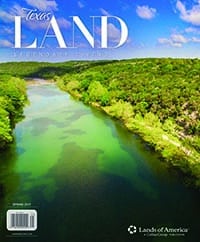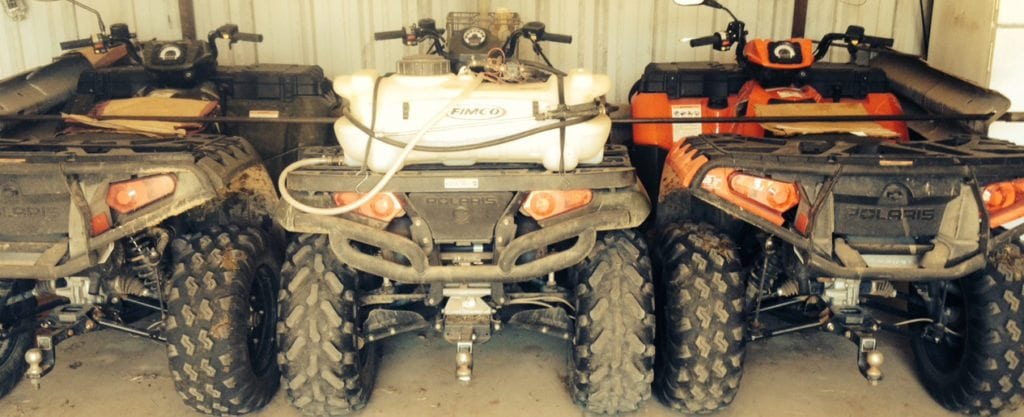
Written by Austin E. Brown, Bee County
When the American Civil War was over thousands of Confederate soldiers, being without home or job, went west to Texas to work on the frontier as cattle hands for the early cattlemen who chose that wonderful area of free grass.
They took innovation with them: skills as mule skinners, wild game hunters, craftsmen of all kinds, and, most important, the desire to live and work outside.
They acquired new skills of riding stock horses and handling herds of free-range cattle.
To this new and exciting industry they lent the well-worn “rebel yell” to the driving of cattle, a yell that was feral in nature and that would soon become the early version of the cattle call. With this yell, used to coerce cattle to change directions or just move forward, these men of renown drove the big herds north from deep South Texas to northern markets. From this era a new “job title” was coined — cowboy.
Photo from rancher Chad Lee to show how they keep their ranch ATVs and equipment safely locked away from thieves.Within 10 years, these strong young men would find themselves handling a newly invented ferrous material, barbed wire.
This new metal product would forever change the cattle industry by fencing the open range. The open range years were over. Large crews of former cowboys suddenly became ranch fence builders. They traded their stock horses for teams of mules, supply wagons and post-hole diggers.
They slept on the ground in all types of weather. The great XIT Ranch of the Texas Panhandle required 6,000 miles of barbed wire fence. With this new innovation in ranching came another new job title — fence hand. This class of unsung men contained those who fenced and secured our ranches and some of their early work can still be found today in isolated areas.
The First and Second World Wars changed the lives of many of these ranch laborers, but at the same time, taught them new skills, the most important of which was welding.
By the early 1950s, ranchers were replacing weaker, wooden implements with stronger, longer-lasting metal implements built by the skilled war-welding cowboys. Soon gates were fashioned of metal rod and pipe. Even metal war-surplus landing mats, which had been used in the islands as makeshift runways for war planes, became ranch gates and working-pen fences.
Soon, metal cattle guards, metal cattle chutes, head gates, even metal cattle pens were built and installed.
Then came the iconic metal cattle trailer, with more changes on the way. One day the neighbor had a fancy, new, decorative gate installed on the county road with the addition of a brand logo to the gate. Soon, names were written in metal script explaining who the ranch belonged to, the type of cattle raised therein, and on, and on.
Today, the sky’s the limit! Life-like figures have been added to gated ranch entrances in recent years, depicting cowboys roping, horses bucking, cattle drives, silhouettes of big deer — you name it, you got it. They just keep on ‘a-comin’. As Butch Cassidy said, “Who are those guys?”
A ranch owner must have good ranch hands. They are the men who make the ranch go ‘round. Ranch owners can’t operate with a transient workforce. Good, strong, stable family men, who love their work more than their pay, are those men who build and decorate our ranches.
The Browns of Bee County in South Texas are most fortunate to employ one such man.
Pablo Garcia, our ranch welder and mechanic, is the best in the business. He builds our “stuff.” He builds anything we ask him to build and when done, it is perfect for the use and nice to look at as a bonus.
Garcia was raised in our area and was trained as a mechanic and welder by his father. He is a pipeline class welder. He can do it all. He has built all of our feedlot cattle handling facilities and pens over the 20 years he has worked for us.
Thanks to him, instead of having to stop and open gates, we sail quickly over numerous pipe cattle guards built and installed by him.
The ranch welding shop is his domain and where many of our tools and implements are constructed as well as repaired. We also take in outside welding from other ranchers as time permits. Many of these jobs involve decorative ranch entrances.
It is an honest statement that we would not be able to ranch as effectively in this fast-paced society we live in without Pablo Garcia’s faithful work ethic and the necessities and conveniences he provides for us through his welding skills.
This article appears in the spring 2017 issue of Texas LAND magazine. CLICK HERE to read more and subscribe to future issues.

